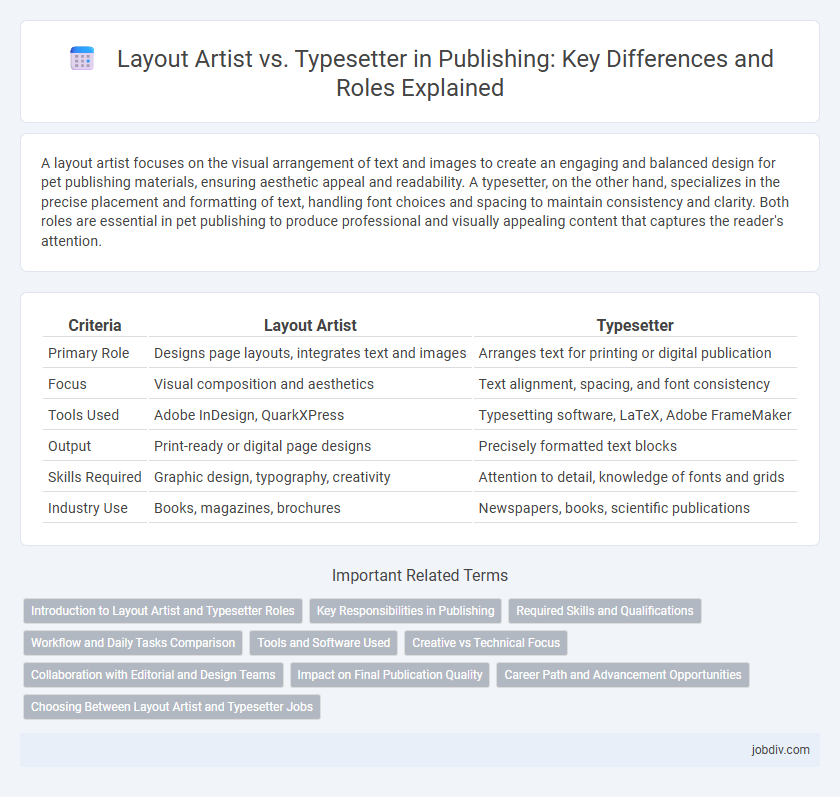A layout artist focuses on the visual arrangement of text and images to create an engaging and balanced design for pet publishing materials, ensuring aesthetic appeal and readability. A typesetter, on the other hand, specializes in the precise placement and formatting of text, handling font choices and spacing to maintain consistency and clarity. Both roles are essential in pet publishing to produce professional and visually appealing content that captures the reader's attention.
Table of Comparison
| Criteria | Layout Artist | Typesetter |
|---|---|---|
| Primary Role | Designs page layouts, integrates text and images | Arranges text for printing or digital publication |
| Focus | Visual composition and aesthetics | Text alignment, spacing, and font consistency |
| Tools Used | Adobe InDesign, QuarkXPress | Typesetting software, LaTeX, Adobe FrameMaker |
| Output | Print-ready or digital page designs | Precisely formatted text blocks |
| Skills Required | Graphic design, typography, creativity | Attention to detail, knowledge of fonts and grids |
| Industry Use | Books, magazines, brochures | Newspapers, books, scientific publications |
Introduction to Layout Artist and Typesetter Roles
Layout artists design the visual structure of publications, arranging text and images to create aesthetically appealing and readable pages. Typesetters focus on the precise placement and formatting of text, ensuring consistency and accuracy in printed materials. Both roles collaborate to produce professional-quality print and digital content in the publishing industry.
Key Responsibilities in Publishing
Layout artists are responsible for arranging text, images, and graphics to create visually appealing page designs that enhance reader engagement and support brand identity. Typesetters focus on the precise arrangement and formatting of text, ensuring consistent font usage, spacing, and alignment to produce clear, readable printed or digital materials. Both roles require strong attention to detail and collaboration with editors and designers to meet publishing standards and deadlines.
Required Skills and Qualifications
Layout artists require proficiency in graphic design software such as Adobe InDesign and Photoshop, strong creative visualization skills, and an eye for balanced composition and color harmony. Typesetters must have expertise in typography, attention to detail for text alignment and spacing, and familiarity with typesetting software like QuarkXPress or LaTeX. Both roles demand excellent understanding of printing processes, production workflows, and knowledge of digital publishing standards.
Workflow and Daily Tasks Comparison
Layout artists focus on designing the overall visual structure, integrating images, text, and graphics to create an appealing page composition using software like Adobe InDesign. Typesetters specialize in arranging and formatting text for readability and consistency, ensuring proper font usage, spacing, and alignment, often working with specialized typesetting programs or markup languages. Both roles collaborate closely in the publishing workflow, with layout artists establishing the page design framework and typesetters refining the text elements to meet publication standards.
Tools and Software Used
Layout artists primarily utilize graphic design software such as Adobe InDesign, QuarkXPress, and Affinity Publisher to arrange visual elements and create cohesive page designs. Typesetters rely on specialized typesetting tools like Adobe InDesign for digital typesetting, LaTeX for academic publications, and traditional software such as QuarkXPress to ensure precise text formatting and character spacing. Both roles often collaborate using overlapping software but focus on different aspects: layout artists on overall visual composition and typesetters on textual accuracy and readability.
Creative vs Technical Focus
Layout artists emphasize creative design, focusing on visual composition, typography, and aesthetics to enhance reader engagement. Typesetters concentrate on the technical precision of text formatting, ensuring accurate font placement, spacing, and adherence to printing standards. Both roles are essential in publishing, balancing artistic innovation with meticulous technical execution.
Collaboration with Editorial and Design Teams
Layout artists collaborate closely with editorial and design teams to ensure visual harmony and readability throughout the publication, integrating text and images seamlessly. Typesetters work with editors to accurately format text according to style guides, maintaining consistency and typographic standards. Both roles require effective communication to align creative design elements with precise text presentation, enhancing overall publication quality.
Impact on Final Publication Quality
A layout artist shapes the visual structure and overall aesthetic of a publication, directly influencing reader engagement through strategic design choices such as typography, spacing, and image placement. In contrast, a typesetter ensures the meticulous alignment and uniformity of text, maintaining clarity and legibility that underpin the publication's professionalism. The synergy between layout artistry and precise typesetting profoundly affects the final quality, balancing creative expression with technical accuracy to enhance both readability and visual appeal.
Career Path and Advancement Opportunities
Layout artists specialize in designing the visual structure of publications, often progressing to senior designer or art director roles by mastering software like Adobe InDesign and enhancing creative skills. Typesetters focus on arranging text for print clarity and accuracy, with career advancement typically leading to supervisory positions or roles in digital typography and prepress management. Both careers benefit from continuous learning in digital publishing trends, improving opportunities in evolving media industries.
Choosing Between Layout Artist and Typesetter Jobs
Choosing between layout artist and typesetter jobs depends on your skills and career goals in publishing. Layout artists focus on designing visually appealing pages using software like Adobe InDesign, emphasizing creativity and graphic design principles. Typesetters specialize in arranging text for optimal readability and print quality, often working with typesetting software such as LaTeX or QuarkXPress to ensure precise text formatting.
Layout Artist vs Typesetter Infographic

 jobdiv.com
jobdiv.com